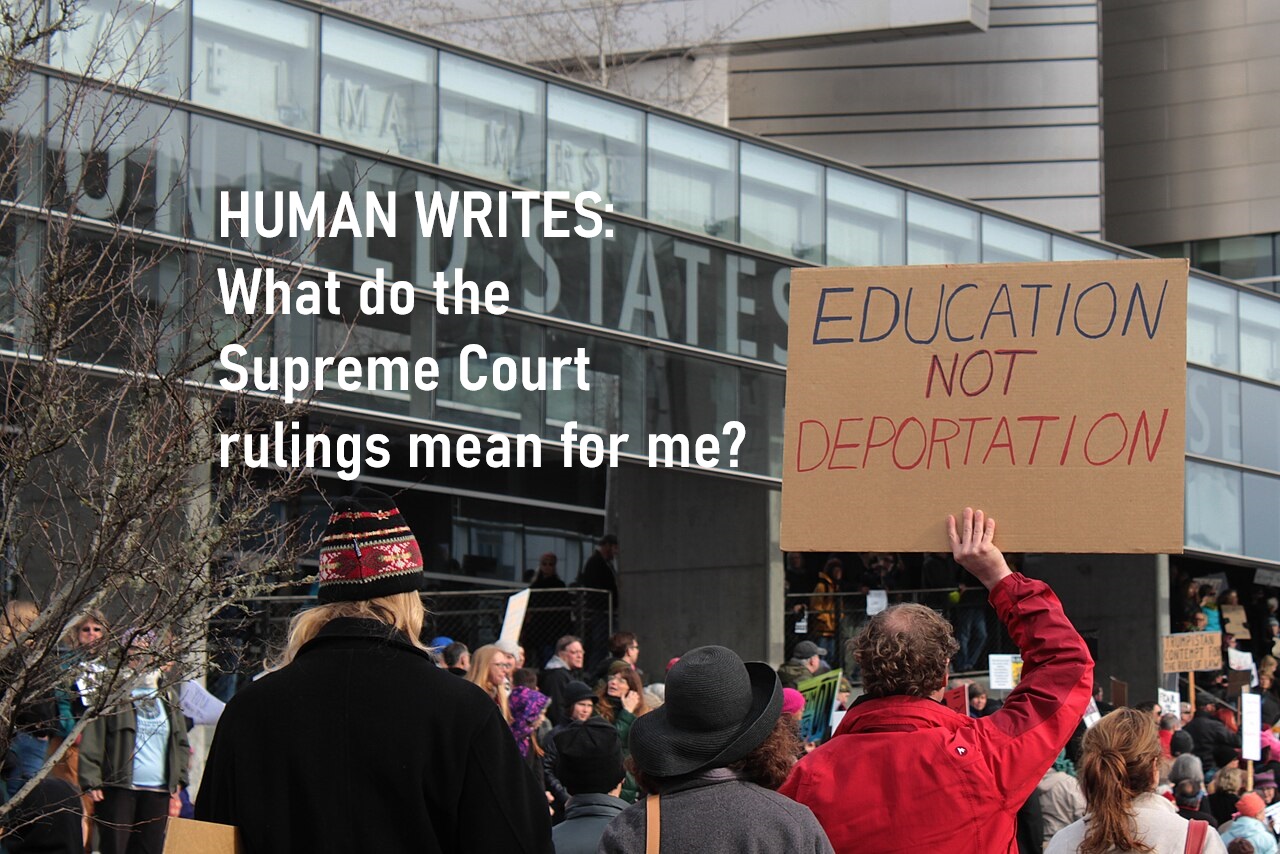HUMAN WRITES – WHAT DOES IT MEAN FOR YOU? Supreme Court allows third-country deportations, despite torture and persecution concerns
Photo by David Geitgey Sierralupe from Eugene, Oregon (photo was edited) (Licensing: https://commons.wikimedia.org/wiki/File:Rally_Against_the_Immigration_Ban_(32487618142).jpg)
By Ananya Roy, News Writer
On Monday, the U.S. Supreme Court ruled on yet another case based on actions and legal directives by President Donald Trump. Many wonder, how will this ruling affect me as a U.S. citizen or as a non-citizen. The Supreme Court lifted limits on a federal district court’s order that restricted the government’s ability to carry out certain deportations. What does that mean for everyday Americans and non-citizens traversing the country or simply living and working in their home state? The 6–3 decision allows the Department of Homeland Security (DHS) to resume removing individuals to third countries with limited notice while legal proceedings continue in the U.S. Court of Appeals for the First Circuit. The Court’s order did not include an explanation, though Justices Elena Kagan and Ketanji Brown Jackson joined Justice Sonia Sotomayor in a dissent.
The case involves an April 18 order by U.S. District Judge Brian Murphy, who had barred the government from deporting migrants to third countries without first confirming they would not face torture or persecution in those countries. His ruling emphasized compliance with procedures under the United Nations Convention Against Torture, specifically providing migrants with adequate notice and an opportunity to raise protection claims. This decision would ensure that deportation practices aligned with both domestic and international standards.
Tensions over the order increased following a May 21 ruling by Judge Murphy, which addressed the attempted removal of eight individuals to South Sudan. According to filings, the government had begun the deportation process without following the steps outlined in the April injunction. The individuals were being deported to South Sudan, despite concerns they could face torture or persecution there, which the court had explicitly required the government to assess beforehand. The plane carrying the eight individuals was rerouted mid-flight to Djibouti, where they currently remain, after legal intervention raised concerns that their deportation to South Sudan violated Judge Murphy’s federal court order. In the May 21 order, Murphy stated that this removal effort effectively violated his earlier directive.
After the Supreme Court lifted the limits of the April 18 order, Solicitor General Henry C. Sauer asked the justices to confirm that the government could proceed with deporting the individuals, now in Djibouti. The request argued that the Supreme Court’s ruling should also apply to Murphy’s May 21 order. In response, the attorneys for the individuals in Djibouti argued that the May 21 decision was a remedy for a prior violation. They emphasized that proper procedures had not been followed and that compliance with the district court’s orders remained necessary.
The Supreme Court’s decision effectively lifts the lower court’s order while the appeal moves forward. Although the majority did not provide any reasoning, Justice Sotomayor authored a strong dissent joined by Justices Kagan and Jackson. The dissent expressed concern over the Court’s intervention in the district court’s ongoing efforts to oversee compliance.
“I cannot join so gross an abuse of the Court’s equitable discretion,” Sotomayor wrote, criticizing the decision to halt the lower court’s order, while significant factual and legal questions remain unresolved. She also noted the district court’s role in managing the case to date: “Only the District Court’s careful attention to this case prevented worse outcomes. Yet today the Court obstructs those proceedings, exposing thousands to the risk of torture or death.”
The dissent further highlighted procedural concerns, particularly surrounding the amount of notice given to individuals facing deportation. In one instance cited in court documents, a migrant was reportedly informed of their removal at 5:45 pm. for a flight scheduled at 9:35 am, the next day. Justice Sotomayor noted that the individual lacked legal representation at the time, writing that such notice “plainly does not afford that non-citizen with a reasonable time to seek relief.”
As the case proceeds through the appeals process, the Supreme Court’s order raises broader questions about the balance between immigration enforcement and procedural safeguards. While the courts have not resolved the underlying legal dispute, it allows deportations to continue under existing federal policy, pending further judicial review.
What does this decision mean for everyday Americans and non-citizens?
The Supreme Court’s decision to lift restrictions on third-country deportations means that, for now, the federal government can resume removing certain immigrants with limited notice—even if they haven’t been given time to challenge their deportation under international protection laws. This could impact other immigrants at risk of being sent to countries where they may face harm, especially those who rely on protections under the Convention Against Torture. While the legal case is still ongoing, the ruling weakens current procedural safeguards and may make it harder for some migrants to assert claims before being deported.





